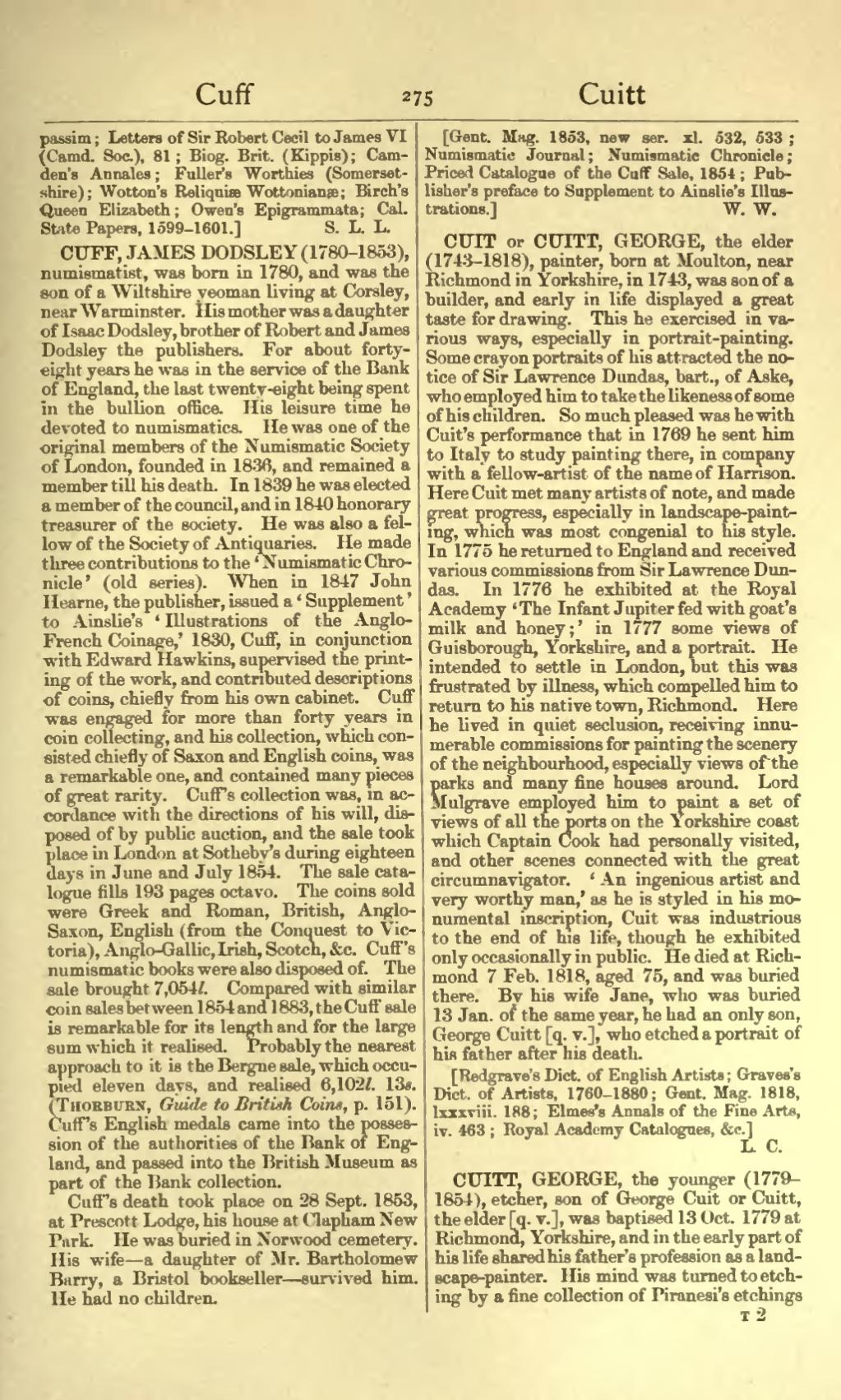passim; Letters of Sir Robert Cecil to James VI (Camd. Soc.), 81; Biog. Brit. (Kippis); Camden's Annales; Fuller's Worthies (Somersetshire); Wotton's Reliquiæ Wottonianæ; Birch's Queen Elizabeth; Owen's Epigrammata; Cal. State Papers, 1599–1601.]
CUFF, JAMES DODSLEY (1780–1853), numismatist, was born in 1780, and was the son of a Wiltshire yeoman living at Corsley, near Warminster. His mother was a daughter of Isaac Dodsley, brother of Robert and James Dodsley the publishers. For about forty-eight years he was in the service of the Bank of England, the last twenty-eight being spent in the bullion office. His leisure time he devoted to numismatics. He was one of the original members of the Numismatic Society of London, founded in 1836, and remained a member till his death. In 1839 he was elected a member of the council, and in 1840 honorary treasurer of the society. He was also a fellow of the Society of Antiquaries. He made three contributions to the ‘Numismatic Chronicle’ (old series). When in 1847 John Hearne, the publisher, issued a ‘Supplement’ to Ainslie's ‘Illustrations of the Anglo-French Coinage,’ 1830, Cuff, in conjunction with Edward Hawkins, supervised the printing of the work, and contributed descriptions of coins, chiefly from his own cabinet. Cuff was engaged for more than forty years in coin collecting, and his collection, which consisted chiefly of Saxon and English coins, was a remarkable one, and contained many pieces of great rarity. Cuff's collection was, in accordance with the directions of his will, disposed of by public auction, and the sale took place in London at Sotheby's during eighteen days in June and July 1854. The sale catalogue fills 193 pages octavo. The coins sold were Greek and Roman, British, Anglo-Saxon, English (from the Conquest to Victoria), Anglo-Gallic, Irish, Scotch, &c. Cuff's numismatic books were also disposed of. The sale brought 7,054l. Compared with similar coin sales between 1854 and 1883, the Cuff sale is remarkable for its length and for the large sum which it realised. Probably the nearest approach to it is the Bergne sale, which occupied eleven days, and realised 6,102l. 13s. (Thorburn, Guide to British Coins, p. 151). Cuff's English medals came into the possession of the authorities of the Bank of England, and passed into the British Museum as part of the Bank collection.
Cuff's death took place on 28 Sept. 1853, at Prescott Lodge, his house at Clapham New Park. He was buried in Norwood cemetery. His wife—a daughter of Mr. Bartholomew Barry, a Bristol bookseller—survived him. He had no children.
[Gent. Mag. 1853, new ser. xl. 532, 533; Numismatic Journal; Numismatic Chronicle; Priced Catalogue of the Cuff Sale, 1854; Publisher's preface to Supplement to Ainslie's Illustrations.]
CUIT or CUITT, GEORGE, the elder (1743–1818), painter, born at Moulton, near Richmond in Yorkshire, in 1743, was son of a builder, and early in life displayed a great taste for drawing. This he exercised in various ways, especially in portrait-painting. Some crayon portraits of his attracted the notice of Sir Lawrence Dundas, bart., of Aske, who employed him to take the likeness of some of his children. So much pleased was he with Cuit's performance that in 1769 he sent him to Italy to study painting there, in company with a fellow-artist, Thomas Harrison (1744–1819) [q. v.] Here Cuit met many artists of note, and made great progress, especially in landscape-painting, which was most congenial to his style. In 1775 he returned to England and received various commissions from Sir Lawrence Dundas. In 1776 he exhibited at the Royal Academy ‘The Infant Jupiter fed with goat's milk and honey;’ in 1777 some views of Guisborough, Yorkshire, and a portrait. He intended to settle in London, but this was frustrated by illness, which compelled him to return to his native town, Richmond. Here he lived in quiet seclusion, receiving innumerable commissions for painting the scenery of the neighbourhood, especially views of the parks and many fine houses around. Lord Mulgrave employed him to paint a set of views of all the ports on the Yorkshire coast which Captain Cook had personally visited, and other scenes connected with the great circumnavigator. ‘An ingenious artist and very worthy man,’ As he is styled in his monumental inscription, Cuit was industrious to the end of his life, though he exhibited only occasionally in public. He died at Richmond 7 Feb. 1818, aged 75, and was buried there. By his wife Jane, who was buried 13 Jan. of the same year, he had an only son, George Cuitt [q. v.], who etched a portrait of his father after his death.
[Redgrave's Dict. of English Artists; Graves's Dict. of Artists, 1760–1880; Gent. Mag. 1818, lxxxviii. 188; Elmes's Annals of the Fine Arts, iv. 463; Royal Academy Catalogues, &c.]
CUITT, GEORGE, the younger (1779–1854), etcher, son of George Cuit or Cuitt, the elder [q. v.], was baptised 13 Oct. 1779 at Richmond, Yorkshire, and in the early part of his life shared his father's profession as a landscape-painter. His mind was turned to etching by a fine collection of Piranesi's etchings
